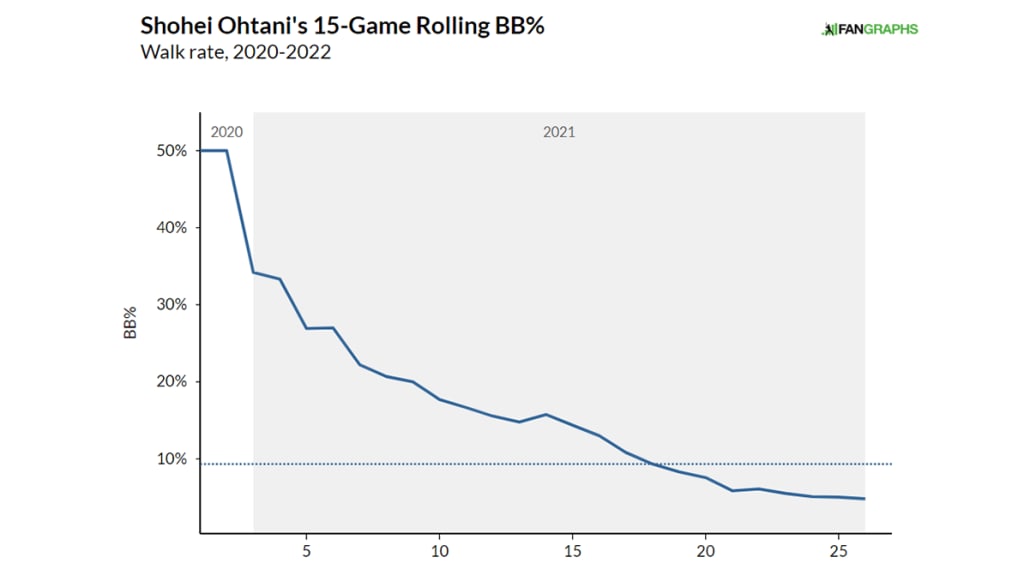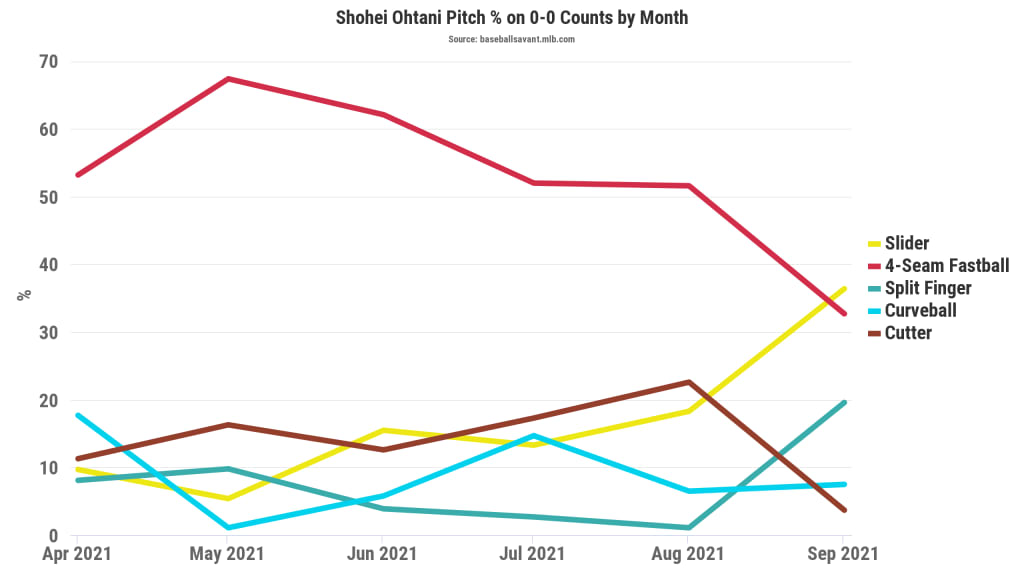It might seem impossible to say that in the midst of the most hyped and well-documented season in recent baseball memory, that there was something that Shohei Ohtani did last year that you might not have noticed, that there was something he got better at as the year went on.
There was, of course. We saw it all the way down the stretch last season. We saw it in his masterful outing on Opening Day. We’ll see it, we imagine, when he starts in Texas on Thursday at 8 p.m. ET, which just so happens to be the MLB.TV Free Game of the Day.
It’s that Ohtani, the pitcher, stopped walking people. He stopped walking just about anyone. It’s as simple as that. There was a thing he was relatively poor at, then he fixed it, and now it’s a strength. Simple to explain, if considerably harder to accomplish.
Sometimes, it’s as easy as presenting the stats, and fortunately for us, he’s made exactly 24 starts since the beginning of the 2021 season. Split them in half, set a minimum of 30 innings thrown in each time period, and …
First 12 starts of 2021-22
April 4, 2021 through June 30, 2021
– 14% walk rate (22nd highest of 280 pitchers)
Most recent 12 starts of 2021-22
July 6, 2021 through April 12, 2022
– 3% walk rate (6th lowest of 304 pitchers)
It’s not a typo. In those first 12 starts, he walked 35 batters in 60 innings. In the most recent 12 starts, he walked 10 in 75 innings. Or, put it like this: Last year, he had two games early on (April 20 vs. Texas and May 5 vs. Tampa Bay) where he walked six batters in a single game. He's walked 10 batters total in his last 12 starts.
So what's happened here is that Ohtani went from being one of the worst pitchers at avoiding walks to one of the best. On a related note, his OBP allowed dropped from .322 to a nearly unfathomable .254.
For the visual learners among you, it looks like this.

Needless to say, there are a ton of benefits here, aside from just “not issuing free passes.” For one thing, it simply meant more Ohtani, because it allowed him to work deeper into games. In those first 12 starts, through June, he averaged an even five innings per start, 60 innings over a dozen starts. In the next 12? He was up to 6.2 innings per start.
But: Why? What changed? For one thing, control is generally considered to be the last thing that comes back after Tommy John surgery, and Ohtani had indeed pitched just 1 2/3 innings in 2020 after undergoing the procedure before the 2019 season.
You might, then, expect that he threw more pitches in the zone. More strikes, fewer balls, fewer walks. Easy, right? Not exactly. If he did throw more pitches in the zone, you certainly didn’t notice it.
The first 12 starts
45% zone rate
The next 12 starts
46% zone rate
Instead, he started simply taking his pitches that batters couldn’t help but go after -- the splitter and the slider -- and throw them more, earlier. Just look at what happened on the first pitch.

While that chart is just showing 2021, it's continued into 2022. In his first start of this season, he threw more first-pitch curveballs than he had in any other start of his career save one.
So now look what happened, against all of his pitches.
The first 12 starts
44% swing rate
25% chase rate (swings at balls)
The next 12 starts
51% swing rate
34% chase rate (swings at balls)
That, right there, is most of it. It might be that he was hitting his spots better, the further he got from Tommy John surgery. But it’s mostly that he was throwing different pitches in different counts, enticing batters to swing at pitches earlier on.
For what it’s worth, that also led to fewer strikeouts. Not that whiffing 28% of your batters faced, as he’s done in the last 12 starts, is a poor number; hardly so. It’s just not quite the 32% he was doing in the first dozen.
It’s a trade-off you’ll take, though. The Ohtani we’re seeing now is a version that’s elite at something new, at not giving batters free passes. (Even the one walk he had on Opening Day came in a plate appearance where he got ahead 0-2 and thought for sure he’d had strike 3 on the next pitch.)
It’s made him more than just the outlier who can be an above-average pitcher while also being a star hitter. Since July 1 of last year, only one regular pitcher has been more difficult to reach base against. That’s Max Scherzer, a no-doubt Hall of Famer. You didn’t think Ohtani could find a way to get any better. If there’s a way to do it quietly, he has. No one gets on for free, not against Ohtani. Not anymore.
